COUADD803A: Substance Abuse Treatment and Coerced Clients Report
VerifiedAdded on 2022/10/04
|37
|7990
|71
Report
AI Summary
This report, submitted by a student and available on Desklib, delves into various aspects of substance abuse treatment. It begins by emphasizing the importance of a therapeutic alliance between counselors and patients, detailing factors that influence patient openness and motivation, and addressing the underlying causes of substance abuse including genetic and environmental factors. The report then presents an intake assessment tool, outlining essential questions about substance abuse history, patterns, triggers, treatment history, willingness to change, and other relevant factors. Finally, the report analyzes the challenges associated with working with coerced or mandated clients, discussing issues such as client attrition, relapse, and the influence of family dynamics, and offers insights into fostering a supportive treatment environment.
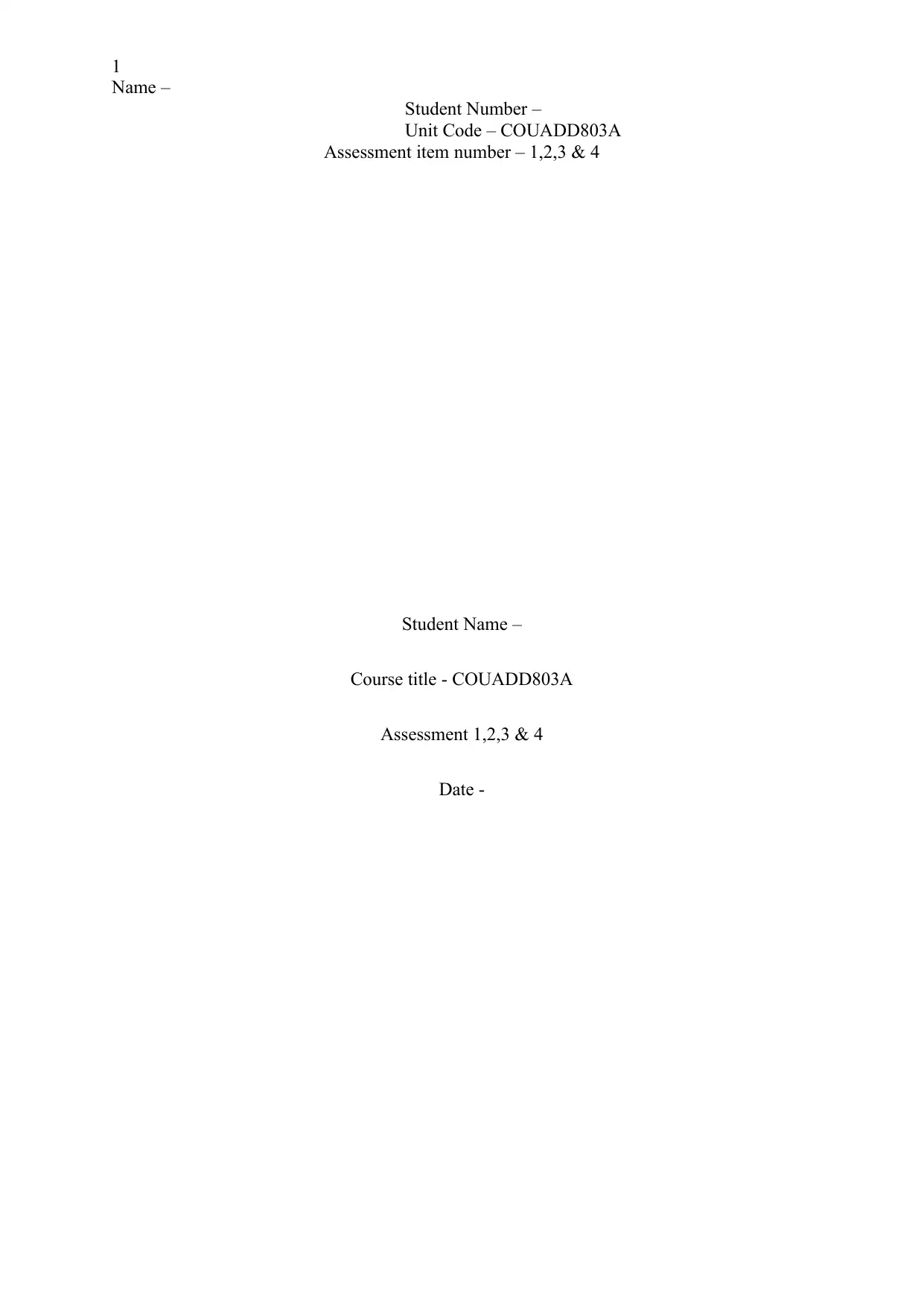
1
Name –
Student Number –
Unit Code – COUADD803A
Assessment item number – 1,2,3 & 4
Student Name –
Course title - COUADD803A
Assessment 1,2,3 & 4
Date -
Name –
Student Number –
Unit Code – COUADD803A
Assessment item number – 1,2,3 & 4
Student Name –
Course title - COUADD803A
Assessment 1,2,3 & 4
Date -
Paraphrase This Document
Need a fresh take? Get an instant paraphrase of this document with our AI Paraphraser
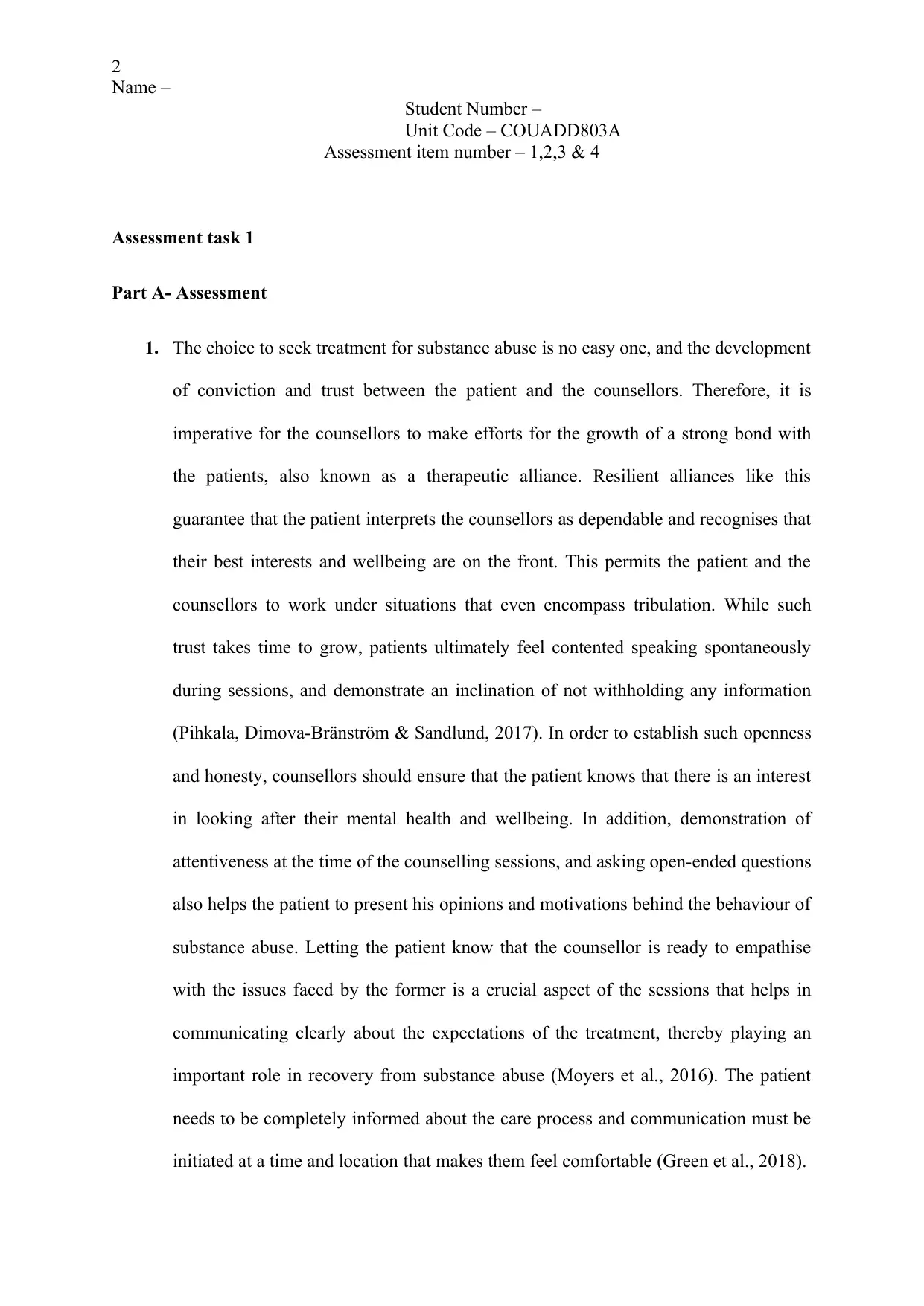
2
Name –
Student Number –
Unit Code – COUADD803A
Assessment item number – 1,2,3 & 4
Assessment task 1
Part A- Assessment
1. The choice to seek treatment for substance abuse is no easy one, and the development
of conviction and trust between the patient and the counsellors. Therefore, it is
imperative for the counsellors to make efforts for the growth of a strong bond with
the patients, also known as a therapeutic alliance. Resilient alliances like this
guarantee that the patient interprets the counsellors as dependable and recognises that
their best interests and wellbeing are on the front. This permits the patient and the
counsellors to work under situations that even encompass tribulation. While such
trust takes time to grow, patients ultimately feel contented speaking spontaneously
during sessions, and demonstrate an inclination of not withholding any information
(Pihkala, Dimova-Bränström & Sandlund, 2017). In order to establish such openness
and honesty, counsellors should ensure that the patient knows that there is an interest
in looking after their mental health and wellbeing. In addition, demonstration of
attentiveness at the time of the counselling sessions, and asking open-ended questions
also helps the patient to present his opinions and motivations behind the behaviour of
substance abuse. Letting the patient know that the counsellor is ready to empathise
with the issues faced by the former is a crucial aspect of the sessions that helps in
communicating clearly about the expectations of the treatment, thereby playing an
important role in recovery from substance abuse (Moyers et al., 2016). The patient
needs to be completely informed about the care process and communication must be
initiated at a time and location that makes them feel comfortable (Green et al., 2018).
Name –
Student Number –
Unit Code – COUADD803A
Assessment item number – 1,2,3 & 4
Assessment task 1
Part A- Assessment
1. The choice to seek treatment for substance abuse is no easy one, and the development
of conviction and trust between the patient and the counsellors. Therefore, it is
imperative for the counsellors to make efforts for the growth of a strong bond with
the patients, also known as a therapeutic alliance. Resilient alliances like this
guarantee that the patient interprets the counsellors as dependable and recognises that
their best interests and wellbeing are on the front. This permits the patient and the
counsellors to work under situations that even encompass tribulation. While such
trust takes time to grow, patients ultimately feel contented speaking spontaneously
during sessions, and demonstrate an inclination of not withholding any information
(Pihkala, Dimova-Bränström & Sandlund, 2017). In order to establish such openness
and honesty, counsellors should ensure that the patient knows that there is an interest
in looking after their mental health and wellbeing. In addition, demonstration of
attentiveness at the time of the counselling sessions, and asking open-ended questions
also helps the patient to present his opinions and motivations behind the behaviour of
substance abuse. Letting the patient know that the counsellor is ready to empathise
with the issues faced by the former is a crucial aspect of the sessions that helps in
communicating clearly about the expectations of the treatment, thereby playing an
important role in recovery from substance abuse (Moyers et al., 2016). The patient
needs to be completely informed about the care process and communication must be
initiated at a time and location that makes them feel comfortable (Green et al., 2018).
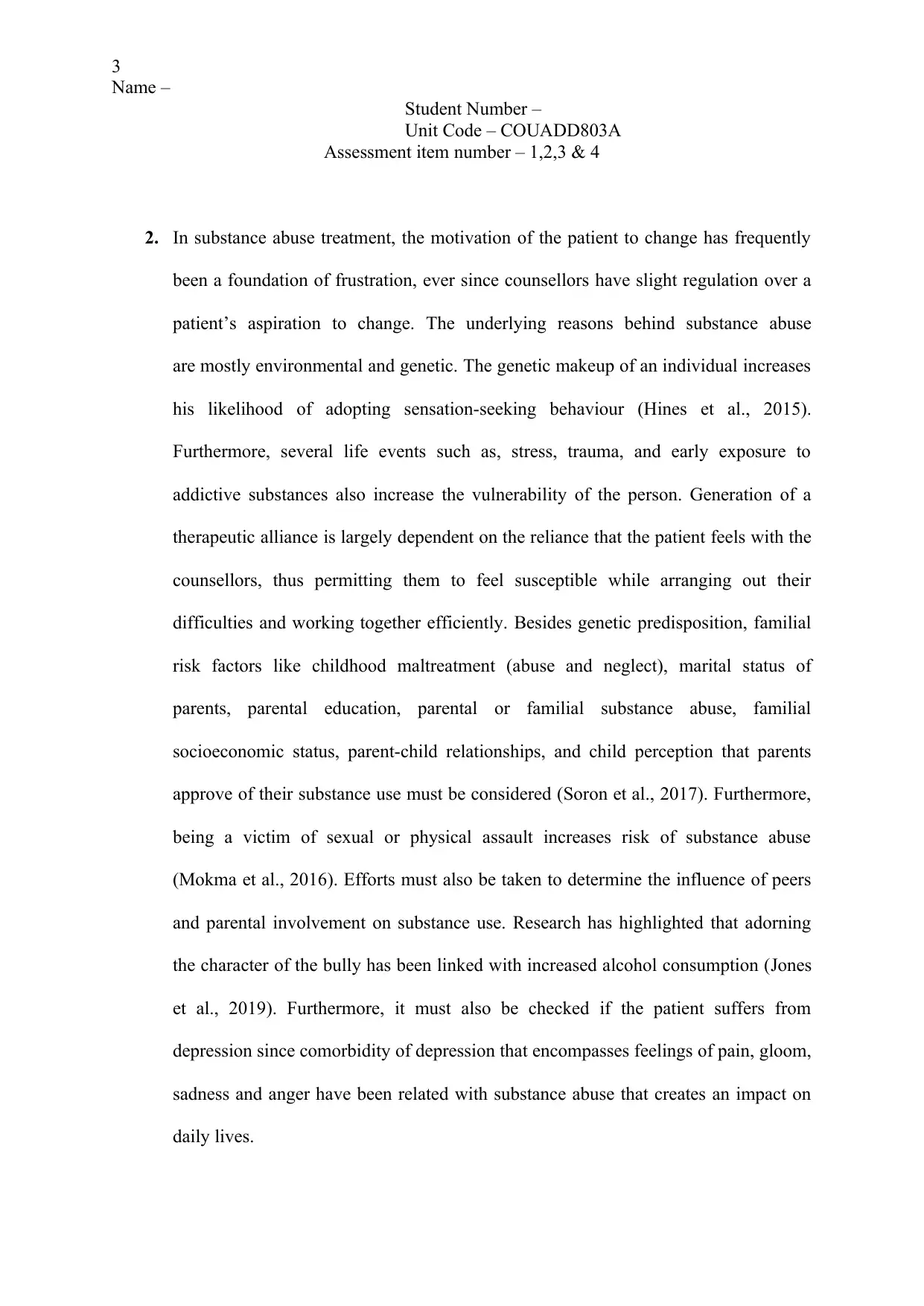
3
Name –
Student Number –
Unit Code – COUADD803A
Assessment item number – 1,2,3 & 4
2. In substance abuse treatment, the motivation of the patient to change has frequently
been a foundation of frustration, ever since counsellors have slight regulation over a
patient’s aspiration to change. The underlying reasons behind substance abuse
are mostly environmental and genetic. The genetic makeup of an individual increases
his likelihood of adopting sensation-seeking behaviour (Hines et al., 2015).
Furthermore, several life events such as, stress, trauma, and early exposure to
addictive substances also increase the vulnerability of the person. Generation of a
therapeutic alliance is largely dependent on the reliance that the patient feels with the
counsellors, thus permitting them to feel susceptible while arranging out their
difficulties and working together efficiently. Besides genetic predisposition, familial
risk factors like childhood maltreatment (abuse and neglect), marital status of
parents, parental education, parental or familial substance abuse, familial
socioeconomic status, parent-child relationships, and child perception that parents
approve of their substance use must be considered (Soron et al., 2017). Furthermore,
being a victim of sexual or physical assault increases risk of substance abuse
(Mokma et al., 2016). Efforts must also be taken to determine the influence of peers
and parental involvement on substance use. Research has highlighted that adorning
the character of the bully has been linked with increased alcohol consumption (Jones
et al., 2019). Furthermore, it must also be checked if the patient suffers from
depression since comorbidity of depression that encompasses feelings of pain, gloom,
sadness and anger have been related with substance abuse that creates an impact on
daily lives.
Name –
Student Number –
Unit Code – COUADD803A
Assessment item number – 1,2,3 & 4
2. In substance abuse treatment, the motivation of the patient to change has frequently
been a foundation of frustration, ever since counsellors have slight regulation over a
patient’s aspiration to change. The underlying reasons behind substance abuse
are mostly environmental and genetic. The genetic makeup of an individual increases
his likelihood of adopting sensation-seeking behaviour (Hines et al., 2015).
Furthermore, several life events such as, stress, trauma, and early exposure to
addictive substances also increase the vulnerability of the person. Generation of a
therapeutic alliance is largely dependent on the reliance that the patient feels with the
counsellors, thus permitting them to feel susceptible while arranging out their
difficulties and working together efficiently. Besides genetic predisposition, familial
risk factors like childhood maltreatment (abuse and neglect), marital status of
parents, parental education, parental or familial substance abuse, familial
socioeconomic status, parent-child relationships, and child perception that parents
approve of their substance use must be considered (Soron et al., 2017). Furthermore,
being a victim of sexual or physical assault increases risk of substance abuse
(Mokma et al., 2016). Efforts must also be taken to determine the influence of peers
and parental involvement on substance use. Research has highlighted that adorning
the character of the bully has been linked with increased alcohol consumption (Jones
et al., 2019). Furthermore, it must also be checked if the patient suffers from
depression since comorbidity of depression that encompasses feelings of pain, gloom,
sadness and anger have been related with substance abuse that creates an impact on
daily lives.
⊘ This is a preview!⊘
Do you want full access?
Subscribe today to unlock all pages.

Trusted by 1+ million students worldwide
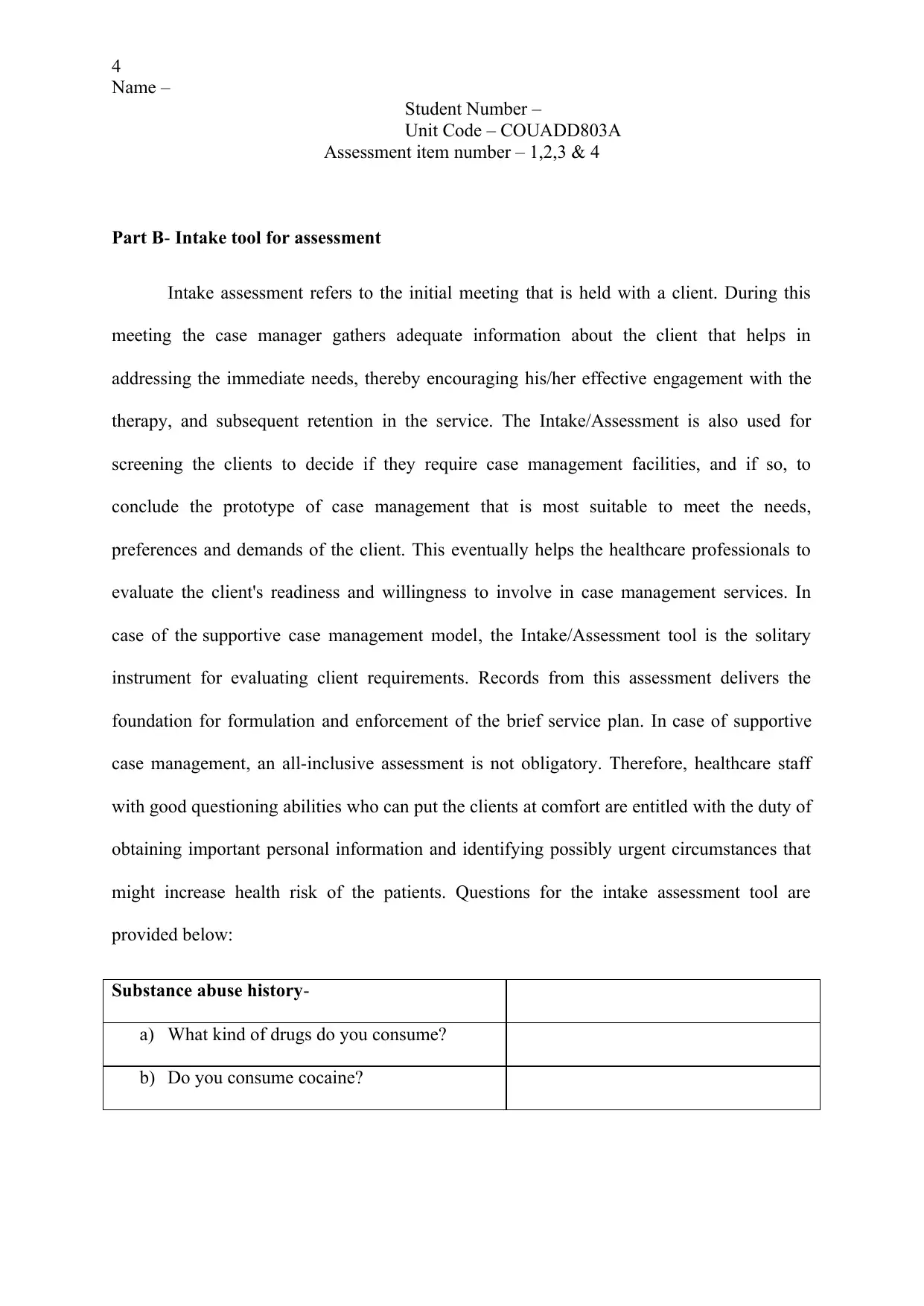
4
Name –
Student Number –
Unit Code – COUADD803A
Assessment item number – 1,2,3 & 4
Part B- Intake tool for assessment
Intake assessment refers to the initial meeting that is held with a client. During this
meeting the case manager gathers adequate information about the client that helps in
addressing the immediate needs, thereby encouraging his/her effective engagement with the
therapy, and subsequent retention in the service. The Intake/Assessment is also used for
screening the clients to decide if they require case management facilities, and if so, to
conclude the prototype of case management that is most suitable to meet the needs,
preferences and demands of the client. This eventually helps the healthcare professionals to
evaluate the client's readiness and willingness to involve in case management services. In
case of the supportive case management model, the Intake/Assessment tool is the solitary
instrument for evaluating client requirements. Records from this assessment delivers the
foundation for formulation and enforcement of the brief service plan. In case of supportive
case management, an all-inclusive assessment is not obligatory. Therefore, healthcare staff
with good questioning abilities who can put the clients at comfort are entitled with the duty of
obtaining important personal information and identifying possibly urgent circumstances that
might increase health risk of the patients. Questions for the intake assessment tool are
provided below:
Substance abuse history-
a) What kind of drugs do you consume?
b) Do you consume cocaine?
Name –
Student Number –
Unit Code – COUADD803A
Assessment item number – 1,2,3 & 4
Part B- Intake tool for assessment
Intake assessment refers to the initial meeting that is held with a client. During this
meeting the case manager gathers adequate information about the client that helps in
addressing the immediate needs, thereby encouraging his/her effective engagement with the
therapy, and subsequent retention in the service. The Intake/Assessment is also used for
screening the clients to decide if they require case management facilities, and if so, to
conclude the prototype of case management that is most suitable to meet the needs,
preferences and demands of the client. This eventually helps the healthcare professionals to
evaluate the client's readiness and willingness to involve in case management services. In
case of the supportive case management model, the Intake/Assessment tool is the solitary
instrument for evaluating client requirements. Records from this assessment delivers the
foundation for formulation and enforcement of the brief service plan. In case of supportive
case management, an all-inclusive assessment is not obligatory. Therefore, healthcare staff
with good questioning abilities who can put the clients at comfort are entitled with the duty of
obtaining important personal information and identifying possibly urgent circumstances that
might increase health risk of the patients. Questions for the intake assessment tool are
provided below:
Substance abuse history-
a) What kind of drugs do you consume?
b) Do you consume cocaine?
Paraphrase This Document
Need a fresh take? Get an instant paraphrase of this document with our AI Paraphraser
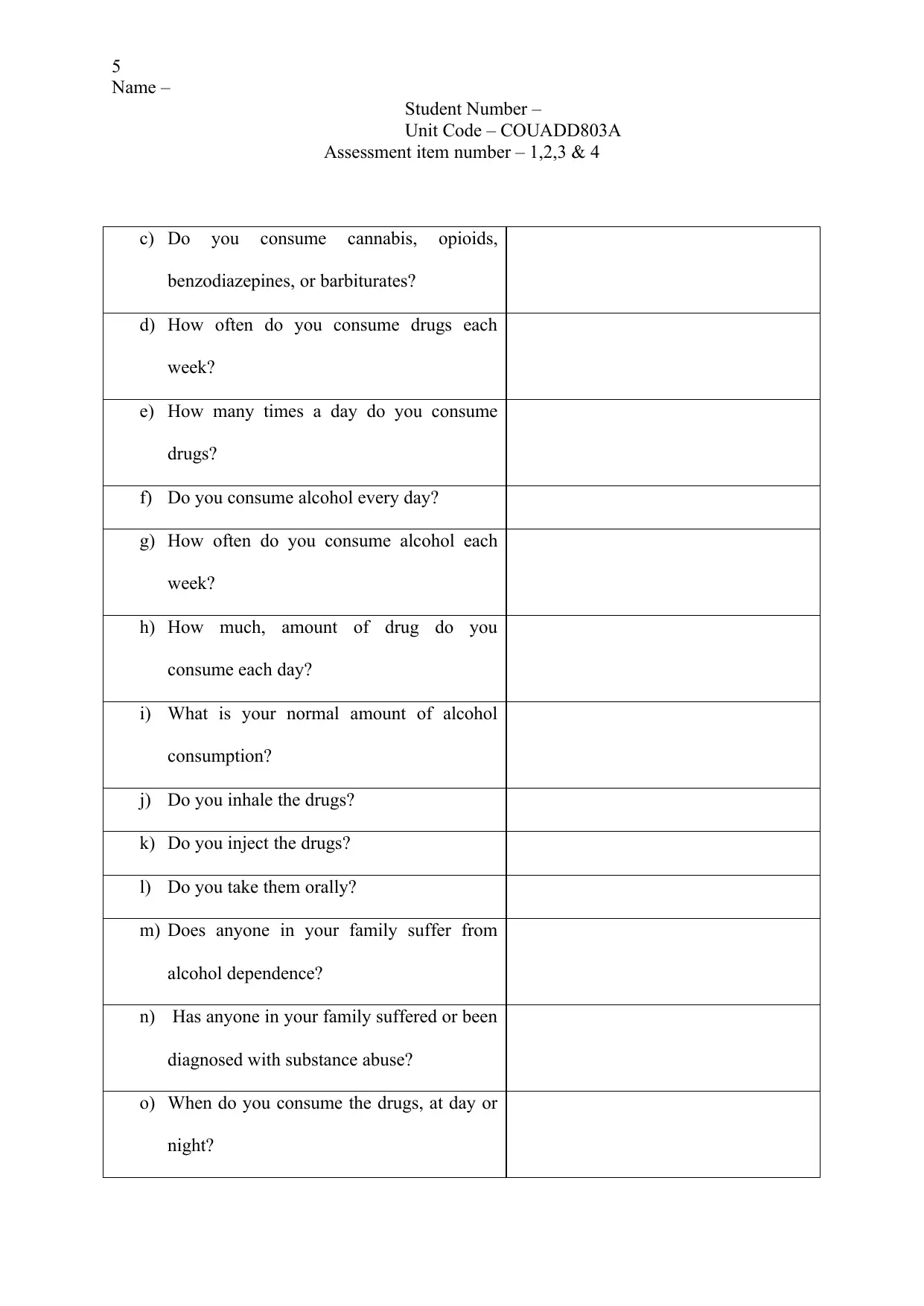
5
Name –
Student Number –
Unit Code – COUADD803A
Assessment item number – 1,2,3 & 4
c) Do you consume cannabis, opioids,
benzodiazepines, or barbiturates?
d) How often do you consume drugs each
week?
e) How many times a day do you consume
drugs?
f) Do you consume alcohol every day?
g) How often do you consume alcohol each
week?
h) How much, amount of drug do you
consume each day?
i) What is your normal amount of alcohol
consumption?
j) Do you inhale the drugs?
k) Do you inject the drugs?
l) Do you take them orally?
m) Does anyone in your family suffer from
alcohol dependence?
n) Has anyone in your family suffered or been
diagnosed with substance abuse?
o) When do you consume the drugs, at day or
night?
Name –
Student Number –
Unit Code – COUADD803A
Assessment item number – 1,2,3 & 4
c) Do you consume cannabis, opioids,
benzodiazepines, or barbiturates?
d) How often do you consume drugs each
week?
e) How many times a day do you consume
drugs?
f) Do you consume alcohol every day?
g) How often do you consume alcohol each
week?
h) How much, amount of drug do you
consume each day?
i) What is your normal amount of alcohol
consumption?
j) Do you inhale the drugs?
k) Do you inject the drugs?
l) Do you take them orally?
m) Does anyone in your family suffer from
alcohol dependence?
n) Has anyone in your family suffered or been
diagnosed with substance abuse?
o) When do you consume the drugs, at day or
night?
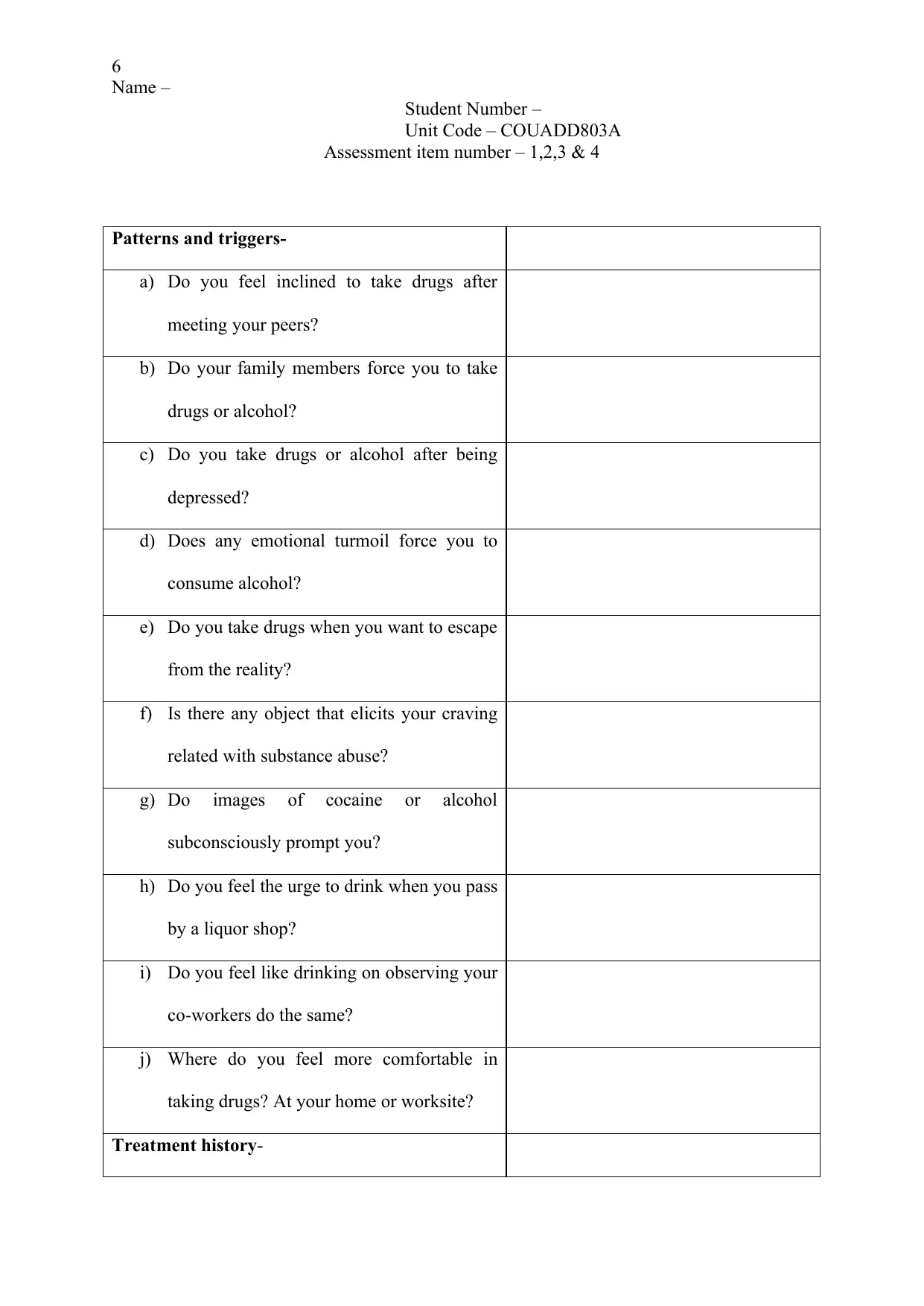
6
Name –
Student Number –
Unit Code – COUADD803A
Assessment item number – 1,2,3 & 4
Patterns and triggers-
a) Do you feel inclined to take drugs after
meeting your peers?
b) Do your family members force you to take
drugs or alcohol?
c) Do you take drugs or alcohol after being
depressed?
d) Does any emotional turmoil force you to
consume alcohol?
e) Do you take drugs when you want to escape
from the reality?
f) Is there any object that elicits your craving
related with substance abuse?
g) Do images of cocaine or alcohol
subconsciously prompt you?
h) Do you feel the urge to drink when you pass
by a liquor shop?
i) Do you feel like drinking on observing your
co-workers do the same?
j) Where do you feel more comfortable in
taking drugs? At your home or worksite?
Treatment history-
Name –
Student Number –
Unit Code – COUADD803A
Assessment item number – 1,2,3 & 4
Patterns and triggers-
a) Do you feel inclined to take drugs after
meeting your peers?
b) Do your family members force you to take
drugs or alcohol?
c) Do you take drugs or alcohol after being
depressed?
d) Does any emotional turmoil force you to
consume alcohol?
e) Do you take drugs when you want to escape
from the reality?
f) Is there any object that elicits your craving
related with substance abuse?
g) Do images of cocaine or alcohol
subconsciously prompt you?
h) Do you feel the urge to drink when you pass
by a liquor shop?
i) Do you feel like drinking on observing your
co-workers do the same?
j) Where do you feel more comfortable in
taking drugs? At your home or worksite?
Treatment history-
⊘ This is a preview!⊘
Do you want full access?
Subscribe today to unlock all pages.

Trusted by 1+ million students worldwide
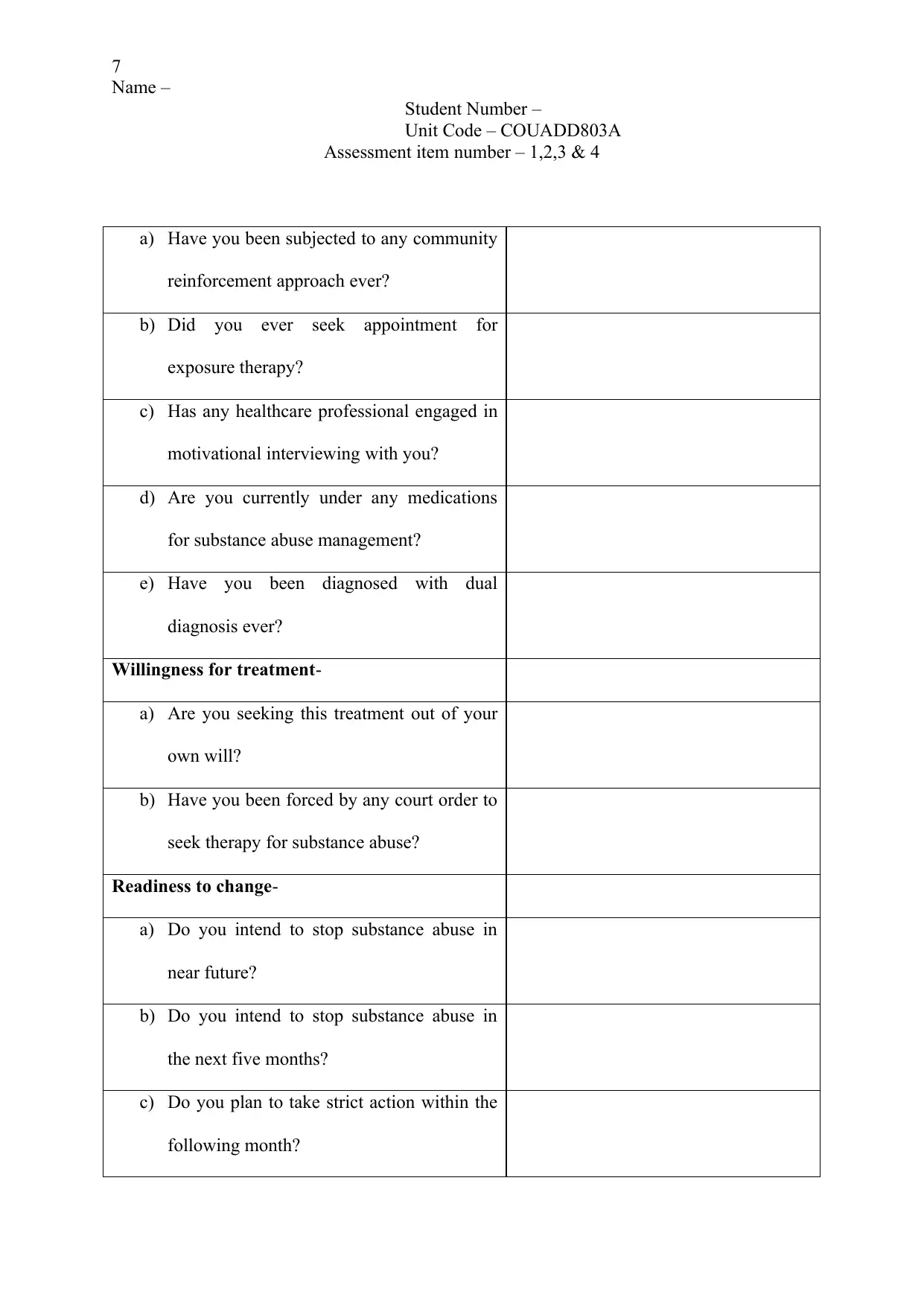
7
Name –
Student Number –
Unit Code – COUADD803A
Assessment item number – 1,2,3 & 4
a) Have you been subjected to any community
reinforcement approach ever?
b) Did you ever seek appointment for
exposure therapy?
c) Has any healthcare professional engaged in
motivational interviewing with you?
d) Are you currently under any medications
for substance abuse management?
e) Have you been diagnosed with dual
diagnosis ever?
Willingness for treatment-
a) Are you seeking this treatment out of your
own will?
b) Have you been forced by any court order to
seek therapy for substance abuse?
Readiness to change-
a) Do you intend to stop substance abuse in
near future?
b) Do you intend to stop substance abuse in
the next five months?
c) Do you plan to take strict action within the
following month?
Name –
Student Number –
Unit Code – COUADD803A
Assessment item number – 1,2,3 & 4
a) Have you been subjected to any community
reinforcement approach ever?
b) Did you ever seek appointment for
exposure therapy?
c) Has any healthcare professional engaged in
motivational interviewing with you?
d) Are you currently under any medications
for substance abuse management?
e) Have you been diagnosed with dual
diagnosis ever?
Willingness for treatment-
a) Are you seeking this treatment out of your
own will?
b) Have you been forced by any court order to
seek therapy for substance abuse?
Readiness to change-
a) Do you intend to stop substance abuse in
near future?
b) Do you intend to stop substance abuse in
the next five months?
c) Do you plan to take strict action within the
following month?
Paraphrase This Document
Need a fresh take? Get an instant paraphrase of this document with our AI Paraphraser
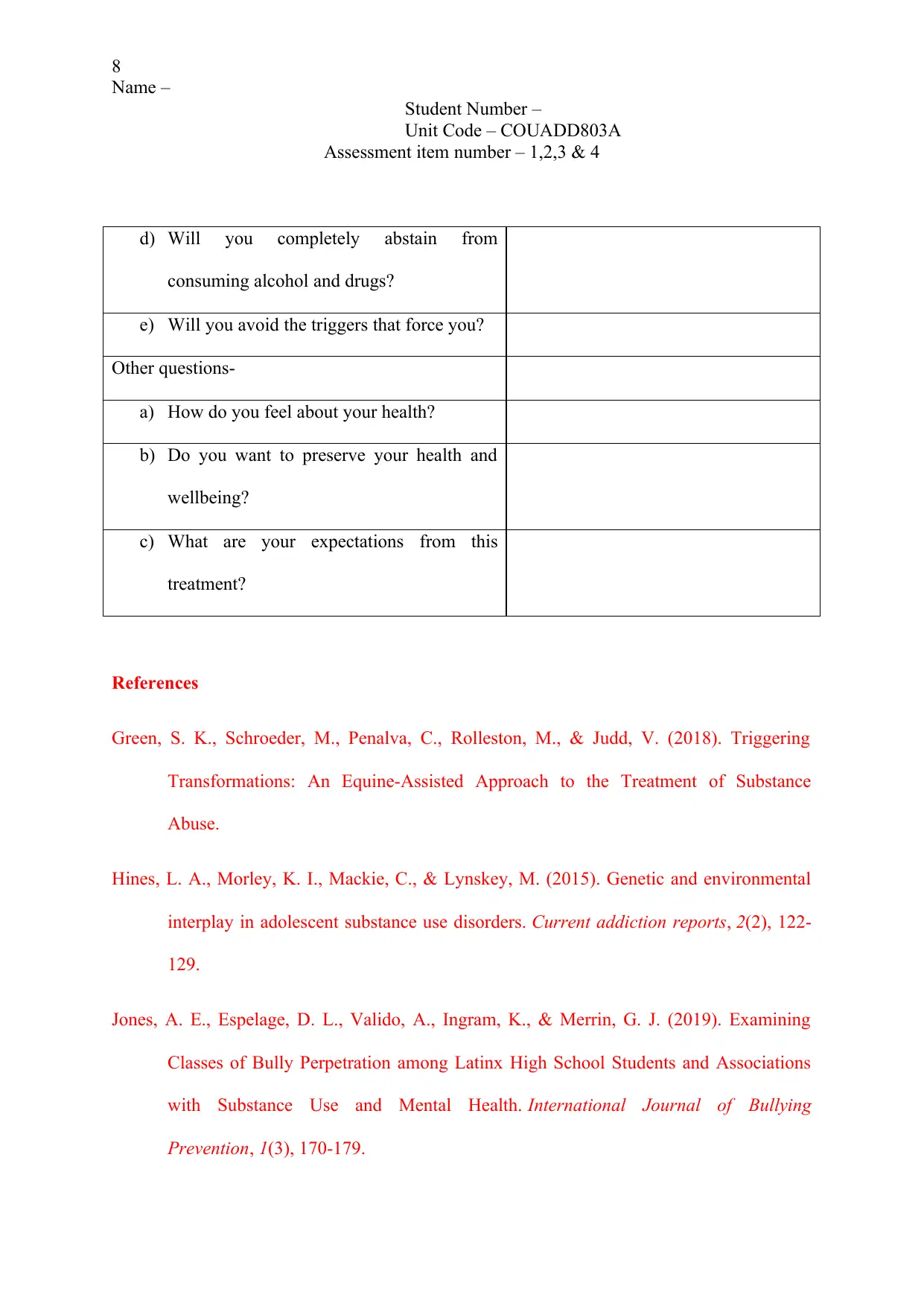
8
Name –
Student Number –
Unit Code – COUADD803A
Assessment item number – 1,2,3 & 4
d) Will you completely abstain from
consuming alcohol and drugs?
e) Will you avoid the triggers that force you?
Other questions-
a) How do you feel about your health?
b) Do you want to preserve your health and
wellbeing?
c) What are your expectations from this
treatment?
References
Green, S. K., Schroeder, M., Penalva, C., Rolleston, M., & Judd, V. (2018). Triggering
Transformations: An Equine-Assisted Approach to the Treatment of Substance
Abuse.
Hines, L. A., Morley, K. I., Mackie, C., & Lynskey, M. (2015). Genetic and environmental
interplay in adolescent substance use disorders. Current addiction reports, 2(2), 122-
129.
Jones, A. E., Espelage, D. L., Valido, A., Ingram, K., & Merrin, G. J. (2019). Examining
Classes of Bully Perpetration among Latinx High School Students and Associations
with Substance Use and Mental Health. International Journal of Bullying
Prevention, 1(3), 170-179.
Name –
Student Number –
Unit Code – COUADD803A
Assessment item number – 1,2,3 & 4
d) Will you completely abstain from
consuming alcohol and drugs?
e) Will you avoid the triggers that force you?
Other questions-
a) How do you feel about your health?
b) Do you want to preserve your health and
wellbeing?
c) What are your expectations from this
treatment?
References
Green, S. K., Schroeder, M., Penalva, C., Rolleston, M., & Judd, V. (2018). Triggering
Transformations: An Equine-Assisted Approach to the Treatment of Substance
Abuse.
Hines, L. A., Morley, K. I., Mackie, C., & Lynskey, M. (2015). Genetic and environmental
interplay in adolescent substance use disorders. Current addiction reports, 2(2), 122-
129.
Jones, A. E., Espelage, D. L., Valido, A., Ingram, K., & Merrin, G. J. (2019). Examining
Classes of Bully Perpetration among Latinx High School Students and Associations
with Substance Use and Mental Health. International Journal of Bullying
Prevention, 1(3), 170-179.
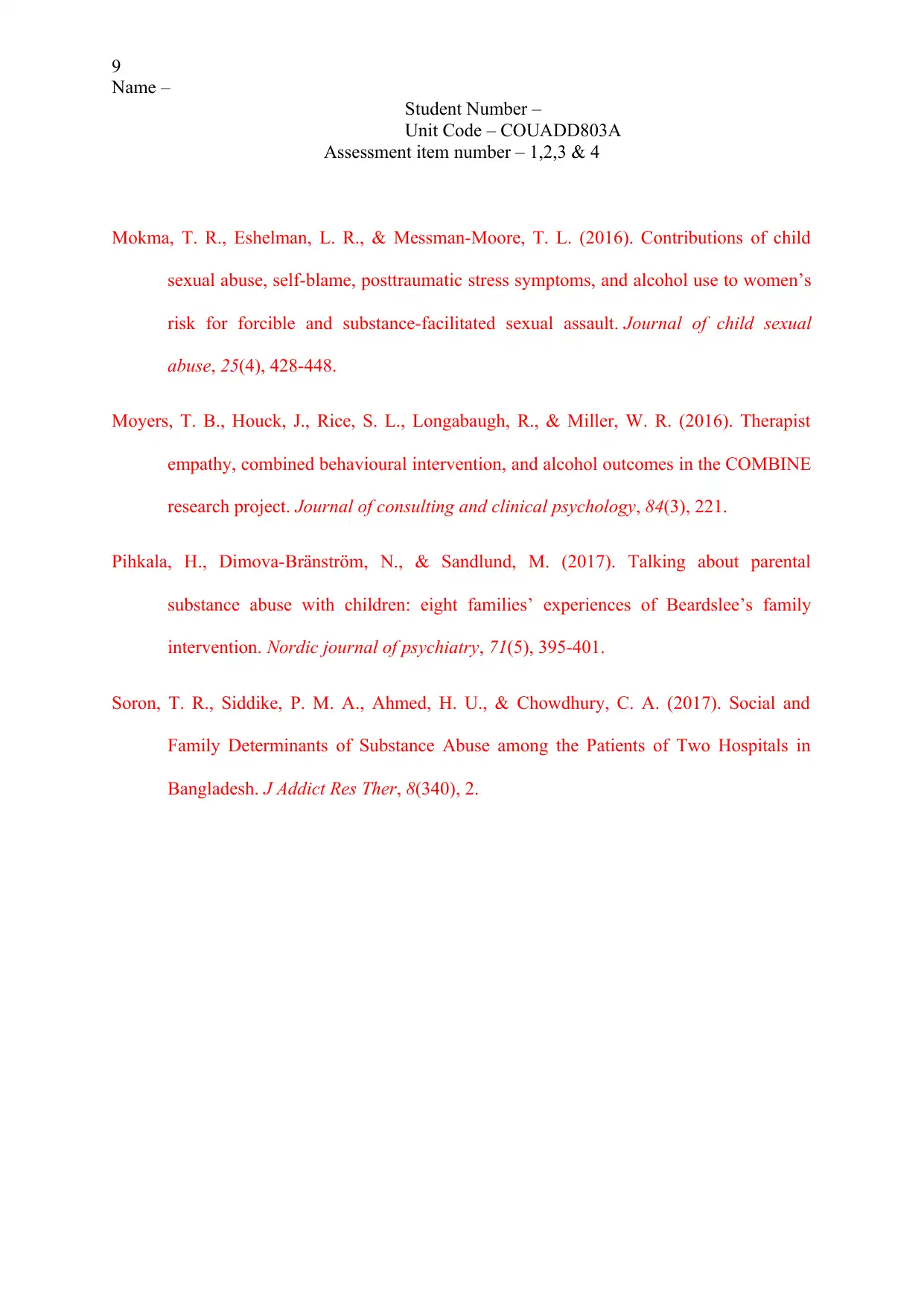
9
Name –
Student Number –
Unit Code – COUADD803A
Assessment item number – 1,2,3 & 4
Mokma, T. R., Eshelman, L. R., & Messman-Moore, T. L. (2016). Contributions of child
sexual abuse, self-blame, posttraumatic stress symptoms, and alcohol use to women’s
risk for forcible and substance-facilitated sexual assault. Journal of child sexual
abuse, 25(4), 428-448.
Moyers, T. B., Houck, J., Rice, S. L., Longabaugh, R., & Miller, W. R. (2016). Therapist
empathy, combined behavioural intervention, and alcohol outcomes in the COMBINE
research project. Journal of consulting and clinical psychology, 84(3), 221.
Pihkala, H., Dimova-Bränström, N., & Sandlund, M. (2017). Talking about parental
substance abuse with children: eight families’ experiences of Beardslee’s family
intervention. Nordic journal of psychiatry, 71(5), 395-401.
Soron, T. R., Siddike, P. M. A., Ahmed, H. U., & Chowdhury, C. A. (2017). Social and
Family Determinants of Substance Abuse among the Patients of Two Hospitals in
Bangladesh. J Addict Res Ther, 8(340), 2.
Name –
Student Number –
Unit Code – COUADD803A
Assessment item number – 1,2,3 & 4
Mokma, T. R., Eshelman, L. R., & Messman-Moore, T. L. (2016). Contributions of child
sexual abuse, self-blame, posttraumatic stress symptoms, and alcohol use to women’s
risk for forcible and substance-facilitated sexual assault. Journal of child sexual
abuse, 25(4), 428-448.
Moyers, T. B., Houck, J., Rice, S. L., Longabaugh, R., & Miller, W. R. (2016). Therapist
empathy, combined behavioural intervention, and alcohol outcomes in the COMBINE
research project. Journal of consulting and clinical psychology, 84(3), 221.
Pihkala, H., Dimova-Bränström, N., & Sandlund, M. (2017). Talking about parental
substance abuse with children: eight families’ experiences of Beardslee’s family
intervention. Nordic journal of psychiatry, 71(5), 395-401.
Soron, T. R., Siddike, P. M. A., Ahmed, H. U., & Chowdhury, C. A. (2017). Social and
Family Determinants of Substance Abuse among the Patients of Two Hospitals in
Bangladesh. J Addict Res Ther, 8(340), 2.
⊘ This is a preview!⊘
Do you want full access?
Subscribe today to unlock all pages.

Trusted by 1+ million students worldwide
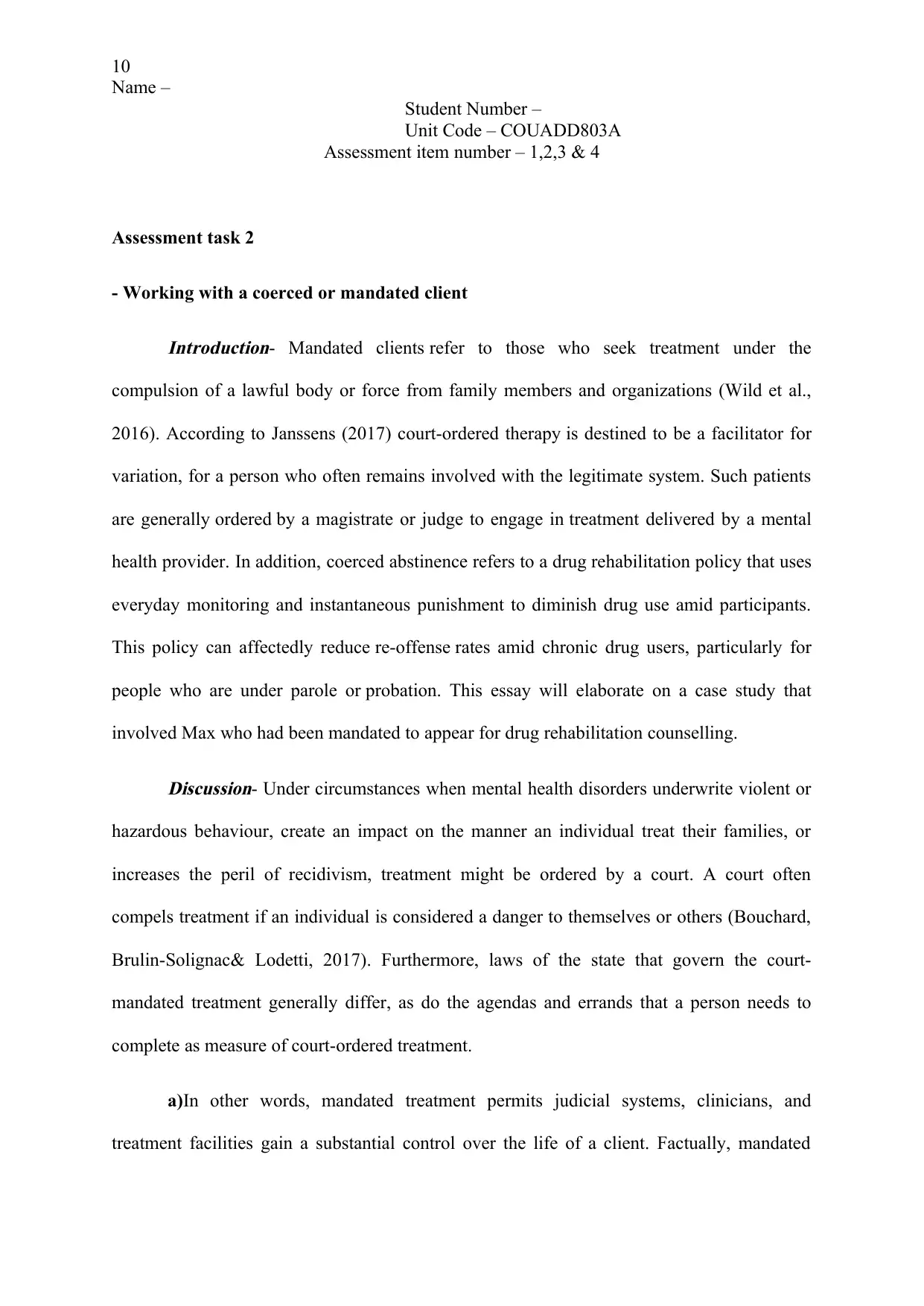
10
Name –
Student Number –
Unit Code – COUADD803A
Assessment item number – 1,2,3 & 4
Assessment task 2
- Working with a coerced or mandated client
Introduction- Mandated clients refer to those who seek treatment under the
compulsion of a lawful body or force from family members and organizations (Wild et al.,
2016). According to Janssens (2017) court-ordered therapy is destined to be a facilitator for
variation, for a person who often remains involved with the legitimate system. Such patients
are generally ordered by a magistrate or judge to engage in treatment delivered by a mental
health provider. In addition, coerced abstinence refers to a drug rehabilitation policy that uses
everyday monitoring and instantaneous punishment to diminish drug use amid participants.
This policy can affectedly reduce re-offense rates amid chronic drug users, particularly for
people who are under parole or probation. This essay will elaborate on a case study that
involved Max who had been mandated to appear for drug rehabilitation counselling.
Discussion- Under circumstances when mental health disorders underwrite violent or
hazardous behaviour, create an impact on the manner an individual treat their families, or
increases the peril of recidivism, treatment might be ordered by a court. A court often
compels treatment if an individual is considered a danger to themselves or others (Bouchard,
Brulin-Solignac& Lodetti, 2017). Furthermore, laws of the state that govern the court-
mandated treatment generally differ, as do the agendas and errands that a person needs to
complete as measure of court-ordered treatment.
a)In other words, mandated treatment permits judicial systems, clinicians, and
treatment facilities gain a substantial control over the life of a client. Factually, mandated
Name –
Student Number –
Unit Code – COUADD803A
Assessment item number – 1,2,3 & 4
Assessment task 2
- Working with a coerced or mandated client
Introduction- Mandated clients refer to those who seek treatment under the
compulsion of a lawful body or force from family members and organizations (Wild et al.,
2016). According to Janssens (2017) court-ordered therapy is destined to be a facilitator for
variation, for a person who often remains involved with the legitimate system. Such patients
are generally ordered by a magistrate or judge to engage in treatment delivered by a mental
health provider. In addition, coerced abstinence refers to a drug rehabilitation policy that uses
everyday monitoring and instantaneous punishment to diminish drug use amid participants.
This policy can affectedly reduce re-offense rates amid chronic drug users, particularly for
people who are under parole or probation. This essay will elaborate on a case study that
involved Max who had been mandated to appear for drug rehabilitation counselling.
Discussion- Under circumstances when mental health disorders underwrite violent or
hazardous behaviour, create an impact on the manner an individual treat their families, or
increases the peril of recidivism, treatment might be ordered by a court. A court often
compels treatment if an individual is considered a danger to themselves or others (Bouchard,
Brulin-Solignac& Lodetti, 2017). Furthermore, laws of the state that govern the court-
mandated treatment generally differ, as do the agendas and errands that a person needs to
complete as measure of court-ordered treatment.
a)In other words, mandated treatment permits judicial systems, clinicians, and
treatment facilities gain a substantial control over the life of a client. Factually, mandated
Paraphrase This Document
Need a fresh take? Get an instant paraphrase of this document with our AI Paraphraser
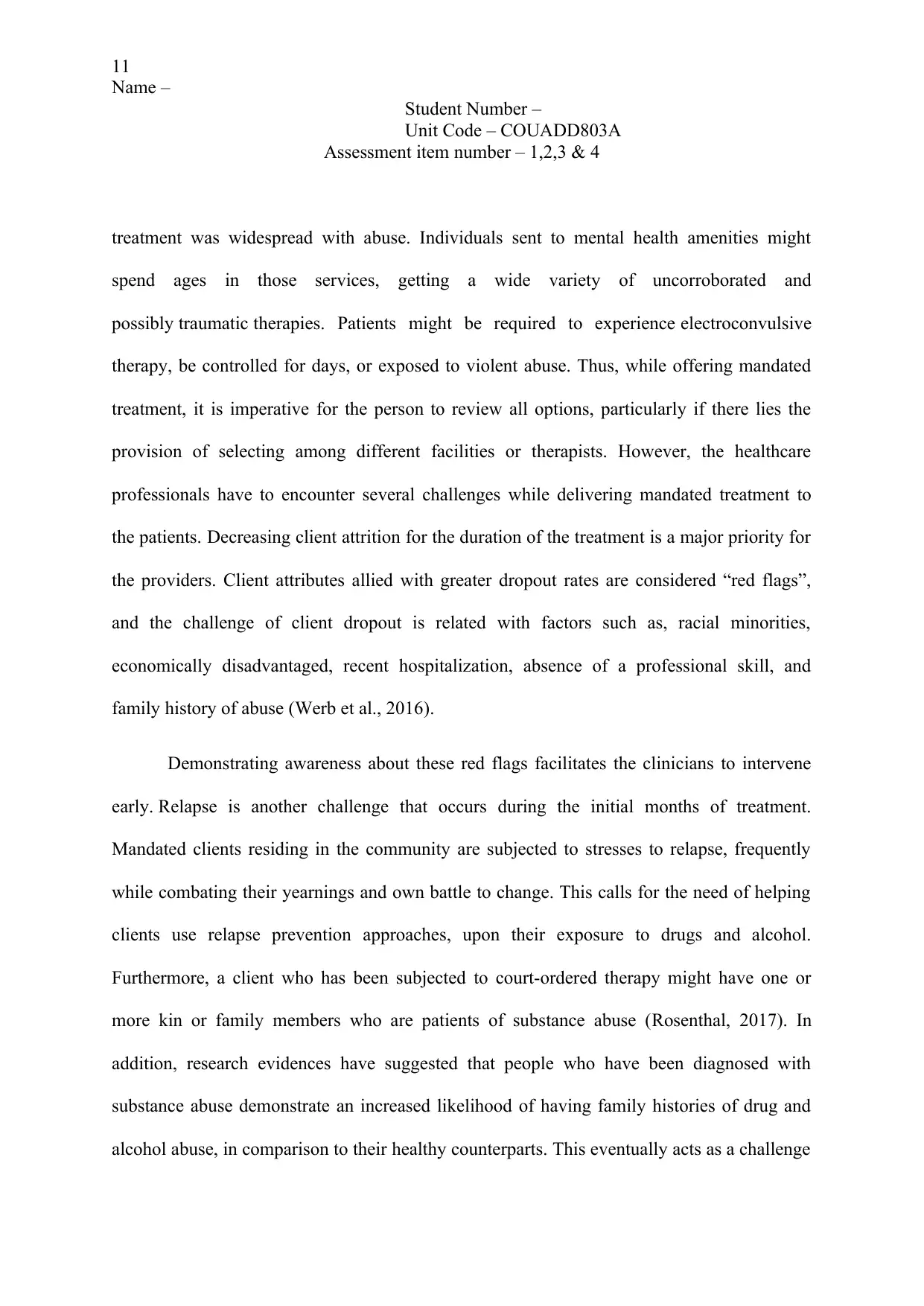
11
Name –
Student Number –
Unit Code – COUADD803A
Assessment item number – 1,2,3 & 4
treatment was widespread with abuse. Individuals sent to mental health amenities might
spend ages in those services, getting a wide variety of uncorroborated and
possibly traumatic therapies. Patients might be required to experience electroconvulsive
therapy, be controlled for days, or exposed to violent abuse. Thus, while offering mandated
treatment, it is imperative for the person to review all options, particularly if there lies the
provision of selecting among different facilities or therapists. However, the healthcare
professionals have to encounter several challenges while delivering mandated treatment to
the patients. Decreasing client attrition for the duration of the treatment is a major priority for
the providers. Client attributes allied with greater dropout rates are considered “red flags”,
and the challenge of client dropout is related with factors such as, racial minorities,
economically disadvantaged, recent hospitalization, absence of a professional skill, and
family history of abuse (Werb et al., 2016).
Demonstrating awareness about these red flags facilitates the clinicians to intervene
early. Relapse is another challenge that occurs during the initial months of treatment.
Mandated clients residing in the community are subjected to stresses to relapse, frequently
while combating their yearnings and own battle to change. This calls for the need of helping
clients use relapse prevention approaches, upon their exposure to drugs and alcohol.
Furthermore, a client who has been subjected to court-ordered therapy might have one or
more kin or family members who are patients of substance abuse (Rosenthal, 2017). In
addition, research evidences have suggested that people who have been diagnosed with
substance abuse demonstrate an increased likelihood of having family histories of drug and
alcohol abuse, in comparison to their healthy counterparts. This eventually acts as a challenge
Name –
Student Number –
Unit Code – COUADD803A
Assessment item number – 1,2,3 & 4
treatment was widespread with abuse. Individuals sent to mental health amenities might
spend ages in those services, getting a wide variety of uncorroborated and
possibly traumatic therapies. Patients might be required to experience electroconvulsive
therapy, be controlled for days, or exposed to violent abuse. Thus, while offering mandated
treatment, it is imperative for the person to review all options, particularly if there lies the
provision of selecting among different facilities or therapists. However, the healthcare
professionals have to encounter several challenges while delivering mandated treatment to
the patients. Decreasing client attrition for the duration of the treatment is a major priority for
the providers. Client attributes allied with greater dropout rates are considered “red flags”,
and the challenge of client dropout is related with factors such as, racial minorities,
economically disadvantaged, recent hospitalization, absence of a professional skill, and
family history of abuse (Werb et al., 2016).
Demonstrating awareness about these red flags facilitates the clinicians to intervene
early. Relapse is another challenge that occurs during the initial months of treatment.
Mandated clients residing in the community are subjected to stresses to relapse, frequently
while combating their yearnings and own battle to change. This calls for the need of helping
clients use relapse prevention approaches, upon their exposure to drugs and alcohol.
Furthermore, a client who has been subjected to court-ordered therapy might have one or
more kin or family members who are patients of substance abuse (Rosenthal, 2017). In
addition, research evidences have suggested that people who have been diagnosed with
substance abuse demonstrate an increased likelihood of having family histories of drug and
alcohol abuse, in comparison to their healthy counterparts. This eventually acts as a challenge
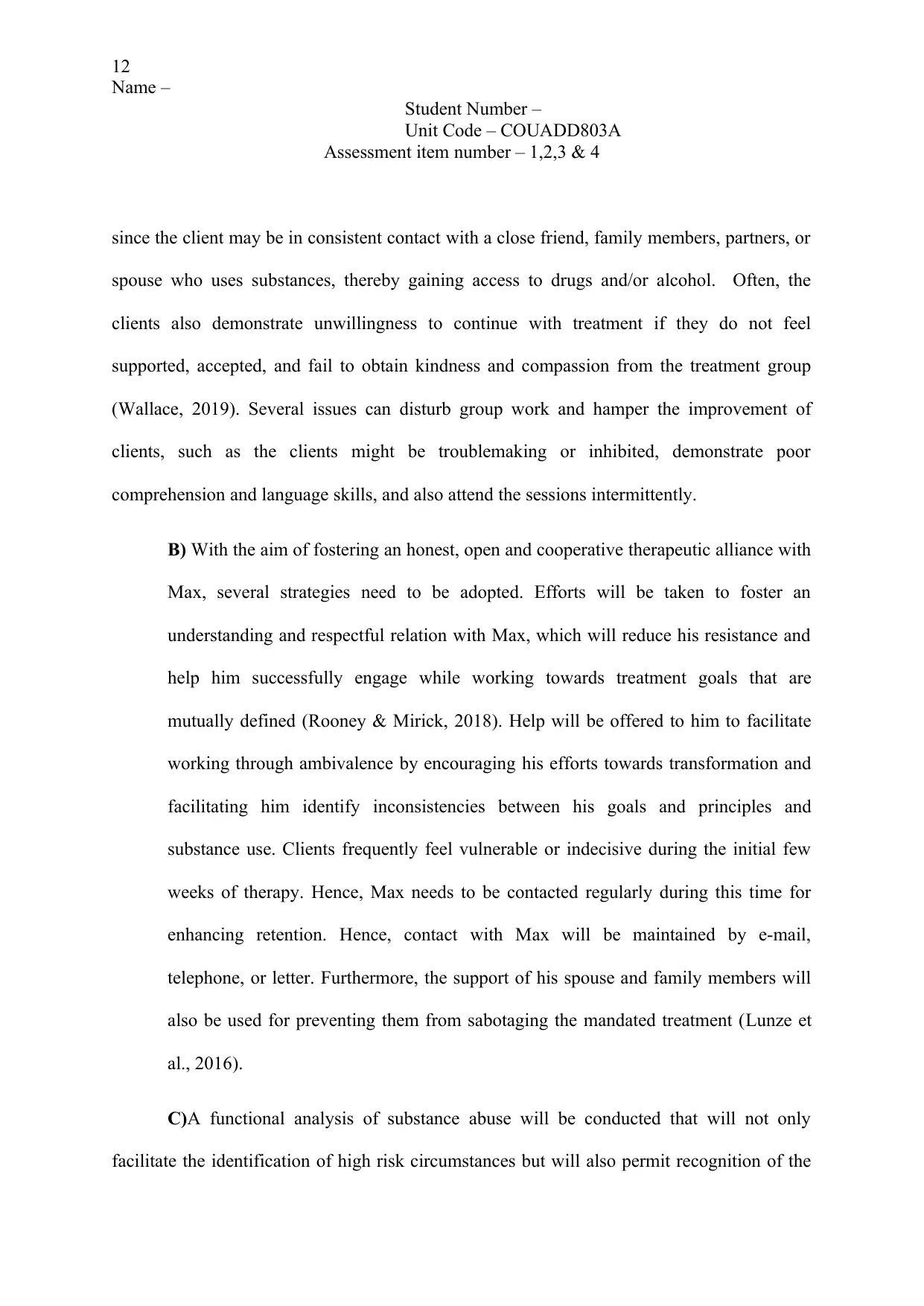
12
Name –
Student Number –
Unit Code – COUADD803A
Assessment item number – 1,2,3 & 4
since the client may be in consistent contact with a close friend, family members, partners, or
spouse who uses substances, thereby gaining access to drugs and/or alcohol. Often, the
clients also demonstrate unwillingness to continue with treatment if they do not feel
supported, accepted, and fail to obtain kindness and compassion from the treatment group
(Wallace, 2019). Several issues can disturb group work and hamper the improvement of
clients, such as the clients might be troublemaking or inhibited, demonstrate poor
comprehension and language skills, and also attend the sessions intermittently.
B) With the aim of fostering an honest, open and cooperative therapeutic alliance with
Max, several strategies need to be adopted. Efforts will be taken to foster an
understanding and respectful relation with Max, which will reduce his resistance and
help him successfully engage while working towards treatment goals that are
mutually defined (Rooney & Mirick, 2018). Help will be offered to him to facilitate
working through ambivalence by encouraging his efforts towards transformation and
facilitating him identify inconsistencies between his goals and principles and
substance use. Clients frequently feel vulnerable or indecisive during the initial few
weeks of therapy. Hence, Max needs to be contacted regularly during this time for
enhancing retention. Hence, contact with Max will be maintained by e-mail,
telephone, or letter. Furthermore, the support of his spouse and family members will
also be used for preventing them from sabotaging the mandated treatment (Lunze et
al., 2016).
C)A functional analysis of substance abuse will be conducted that will not only
facilitate the identification of high risk circumstances but will also permit recognition of the
Name –
Student Number –
Unit Code – COUADD803A
Assessment item number – 1,2,3 & 4
since the client may be in consistent contact with a close friend, family members, partners, or
spouse who uses substances, thereby gaining access to drugs and/or alcohol. Often, the
clients also demonstrate unwillingness to continue with treatment if they do not feel
supported, accepted, and fail to obtain kindness and compassion from the treatment group
(Wallace, 2019). Several issues can disturb group work and hamper the improvement of
clients, such as the clients might be troublemaking or inhibited, demonstrate poor
comprehension and language skills, and also attend the sessions intermittently.
B) With the aim of fostering an honest, open and cooperative therapeutic alliance with
Max, several strategies need to be adopted. Efforts will be taken to foster an
understanding and respectful relation with Max, which will reduce his resistance and
help him successfully engage while working towards treatment goals that are
mutually defined (Rooney & Mirick, 2018). Help will be offered to him to facilitate
working through ambivalence by encouraging his efforts towards transformation and
facilitating him identify inconsistencies between his goals and principles and
substance use. Clients frequently feel vulnerable or indecisive during the initial few
weeks of therapy. Hence, Max needs to be contacted regularly during this time for
enhancing retention. Hence, contact with Max will be maintained by e-mail,
telephone, or letter. Furthermore, the support of his spouse and family members will
also be used for preventing them from sabotaging the mandated treatment (Lunze et
al., 2016).
C)A functional analysis of substance abuse will be conducted that will not only
facilitate the identification of high risk circumstances but will also permit recognition of the
⊘ This is a preview!⊘
Do you want full access?
Subscribe today to unlock all pages.

Trusted by 1+ million students worldwide
1 out of 37
Related Documents
Your All-in-One AI-Powered Toolkit for Academic Success.
+13062052269
info@desklib.com
Available 24*7 on WhatsApp / Email
![[object Object]](/_next/static/media/star-bottom.7253800d.svg)
Unlock your academic potential
Copyright © 2020–2025 A2Z Services. All Rights Reserved. Developed and managed by ZUCOL.




